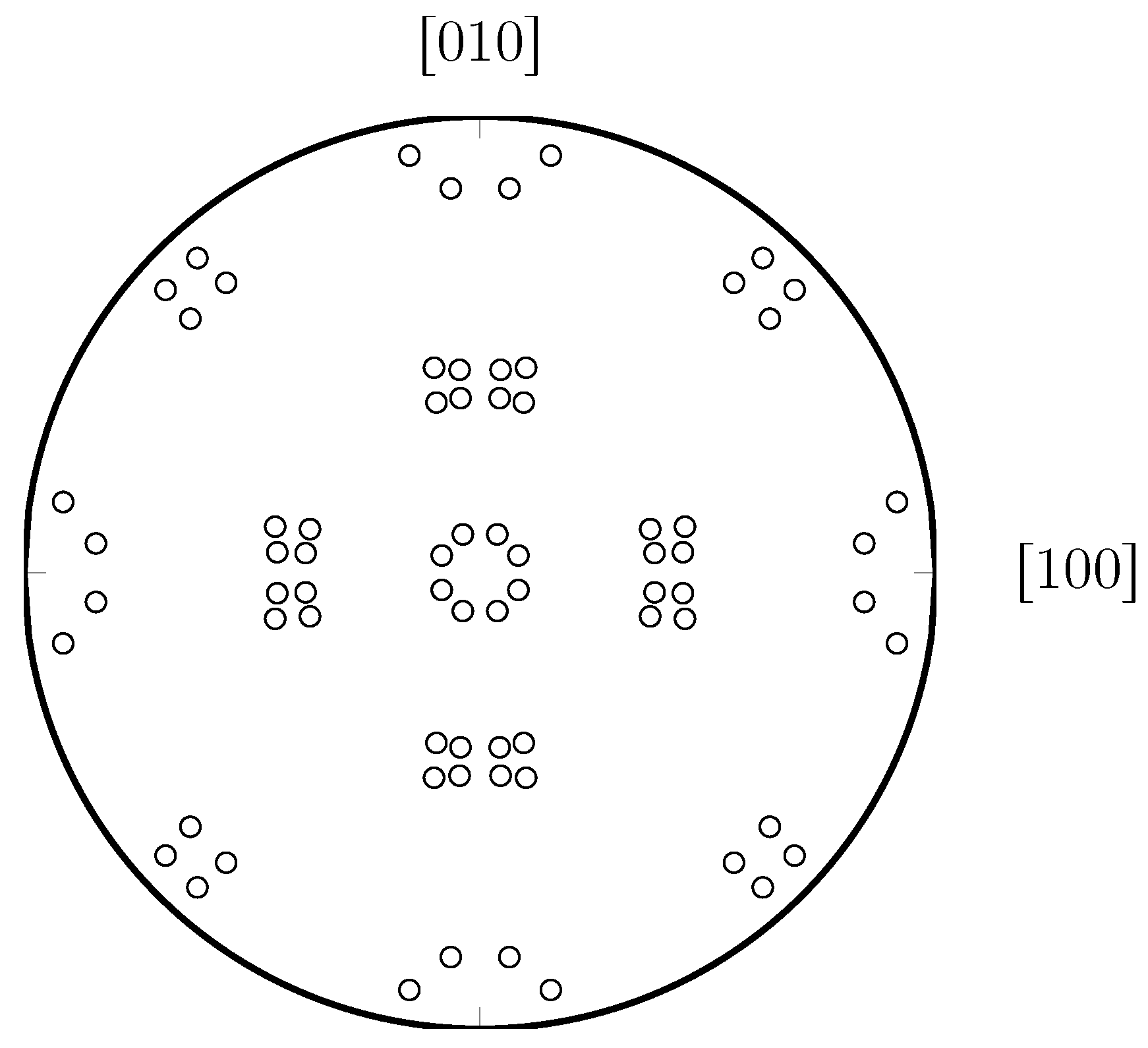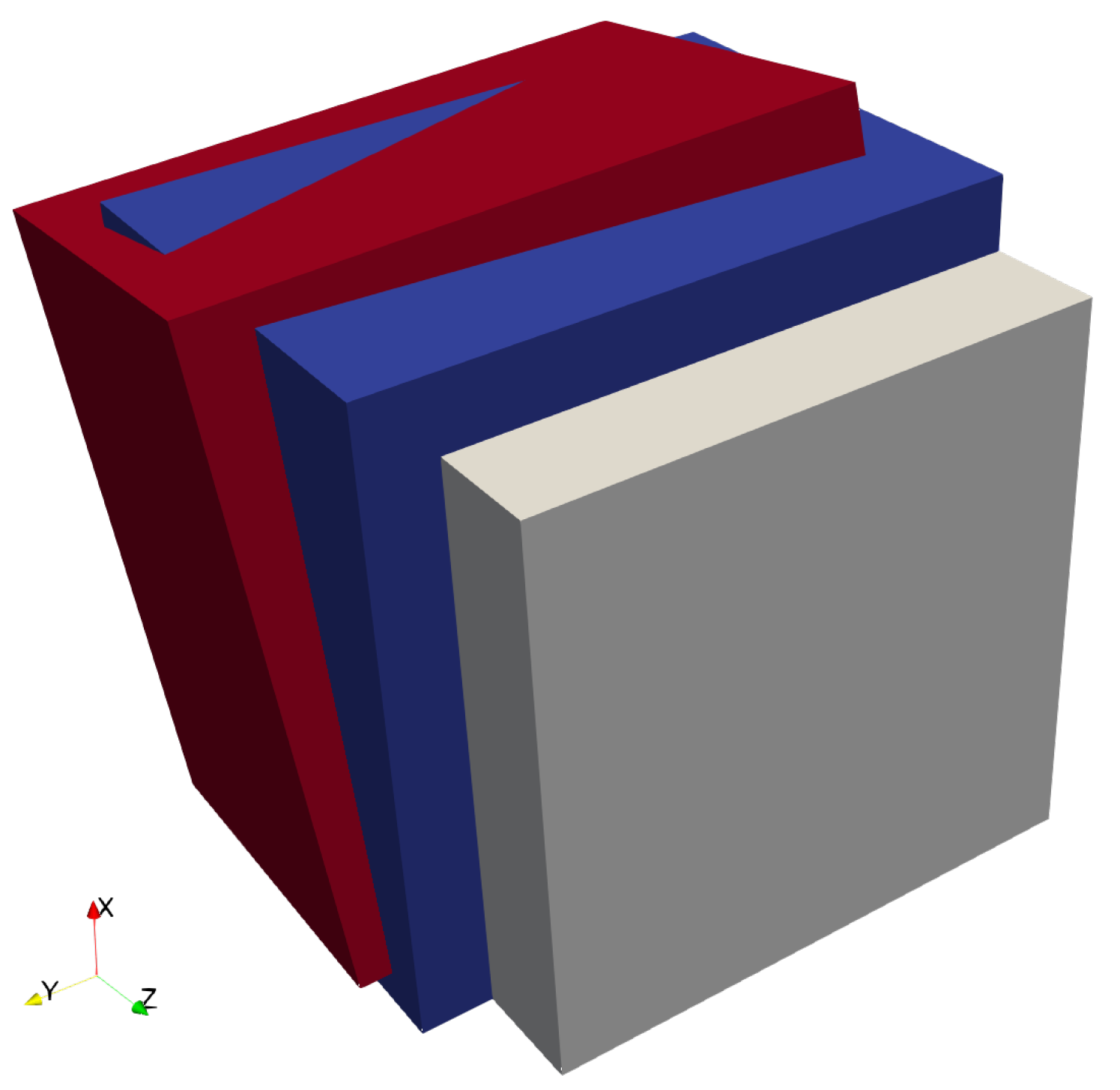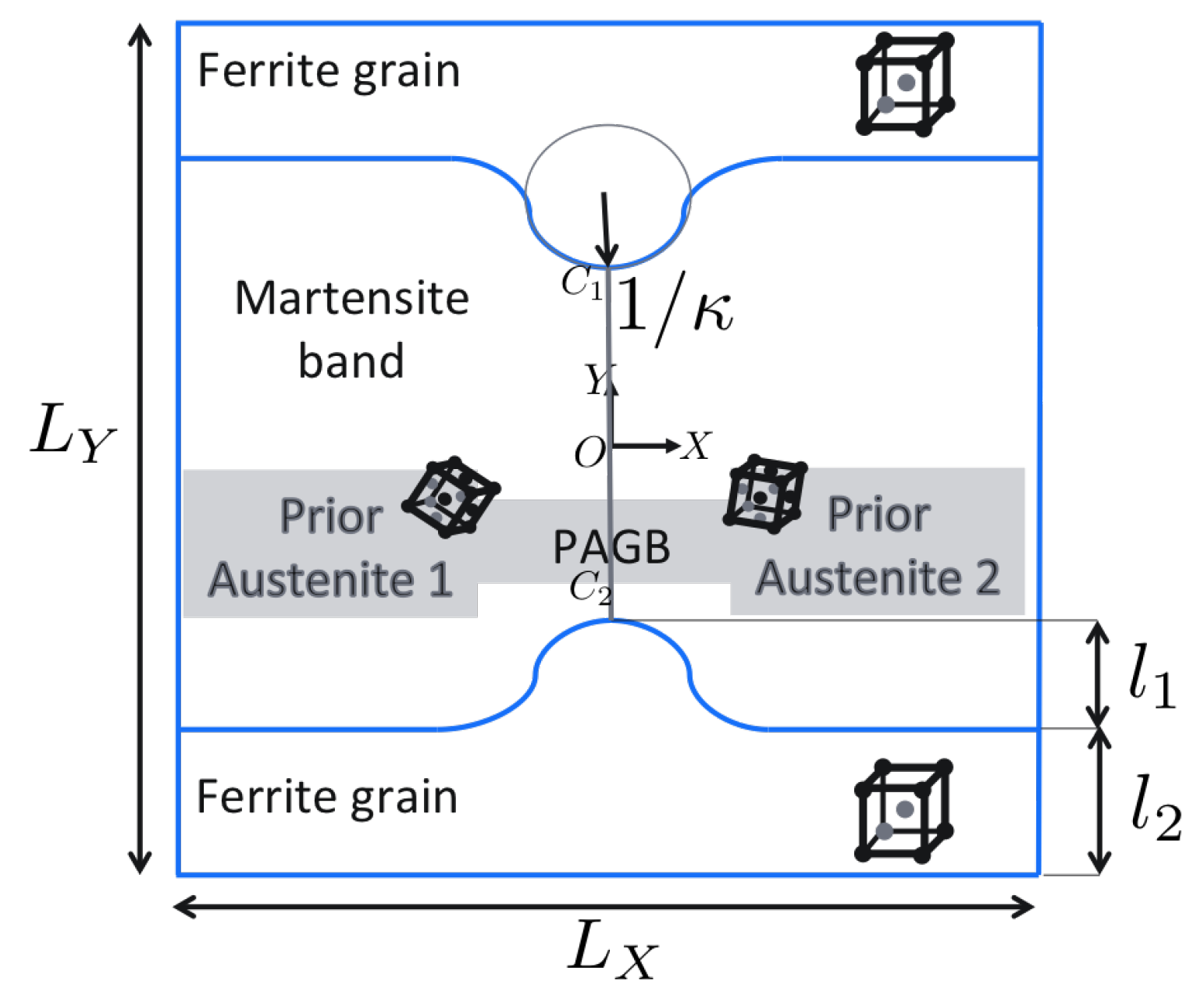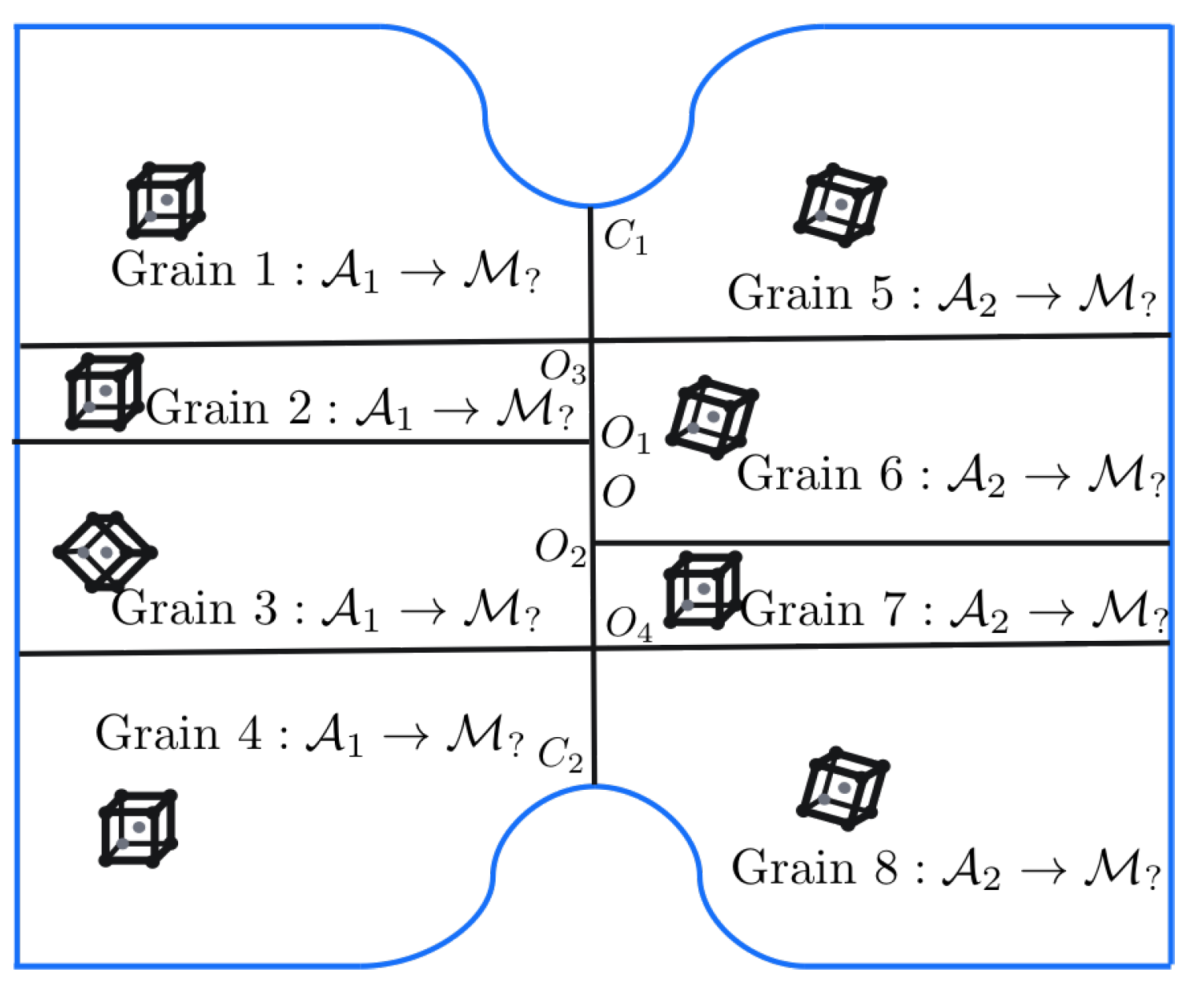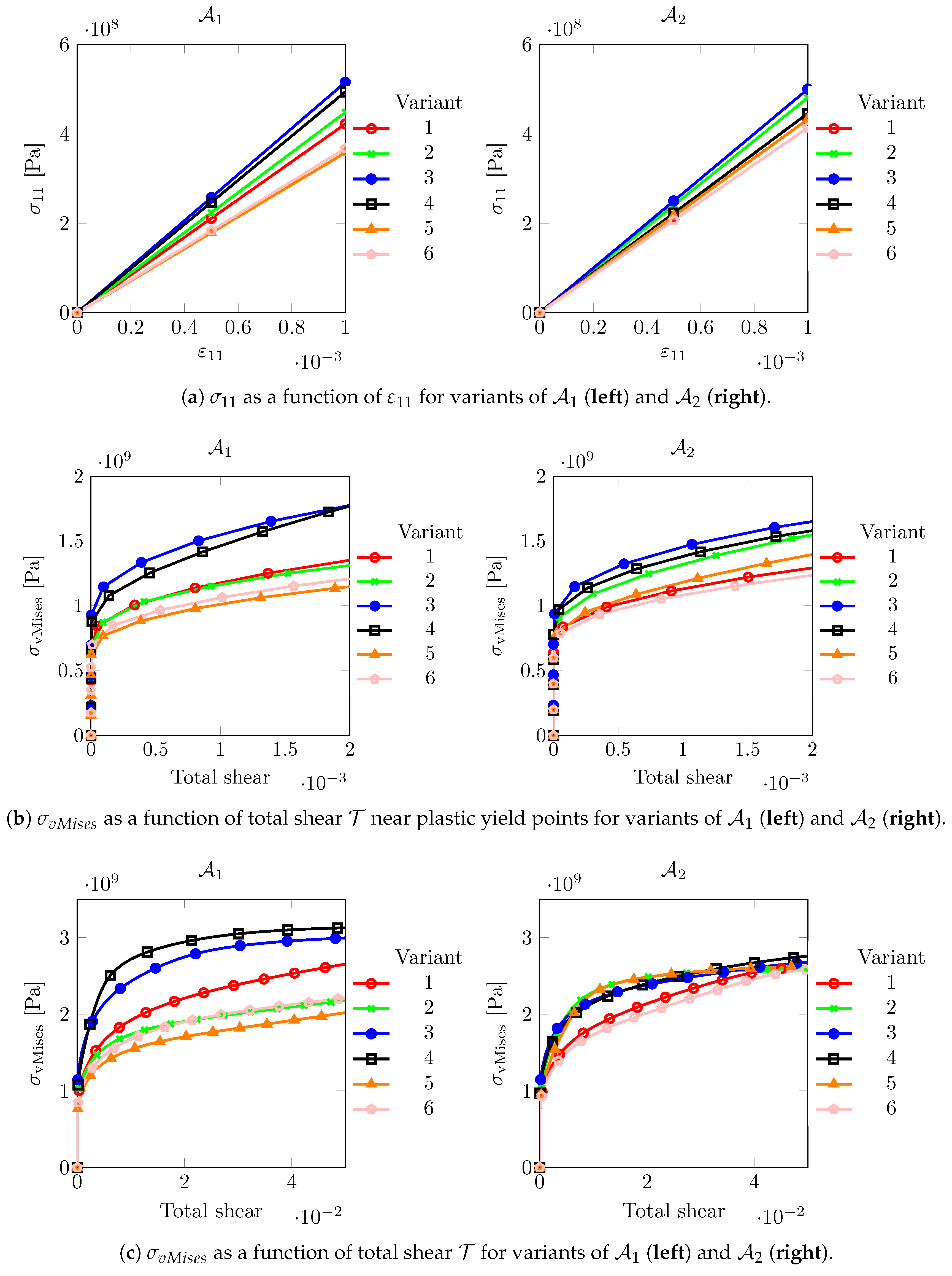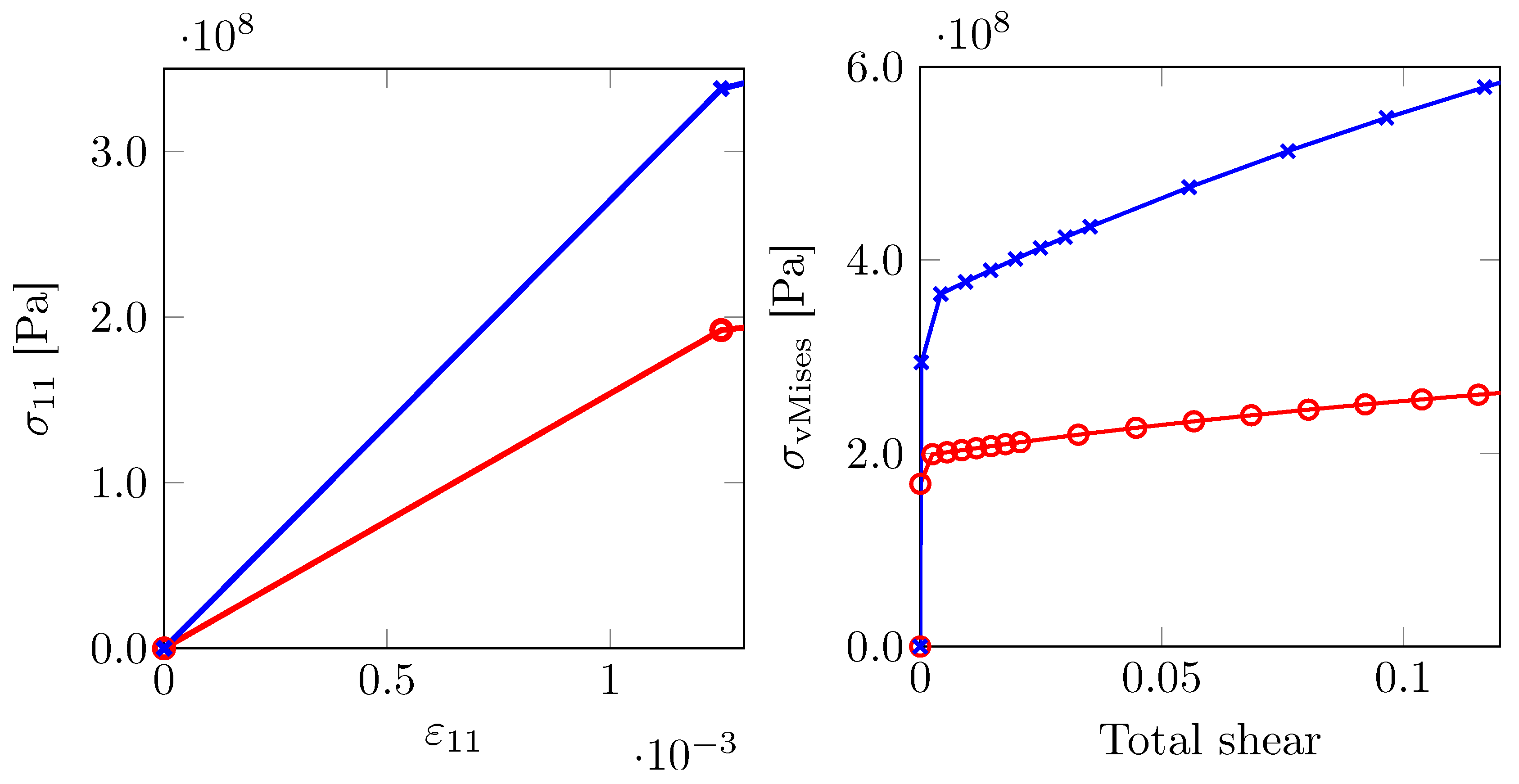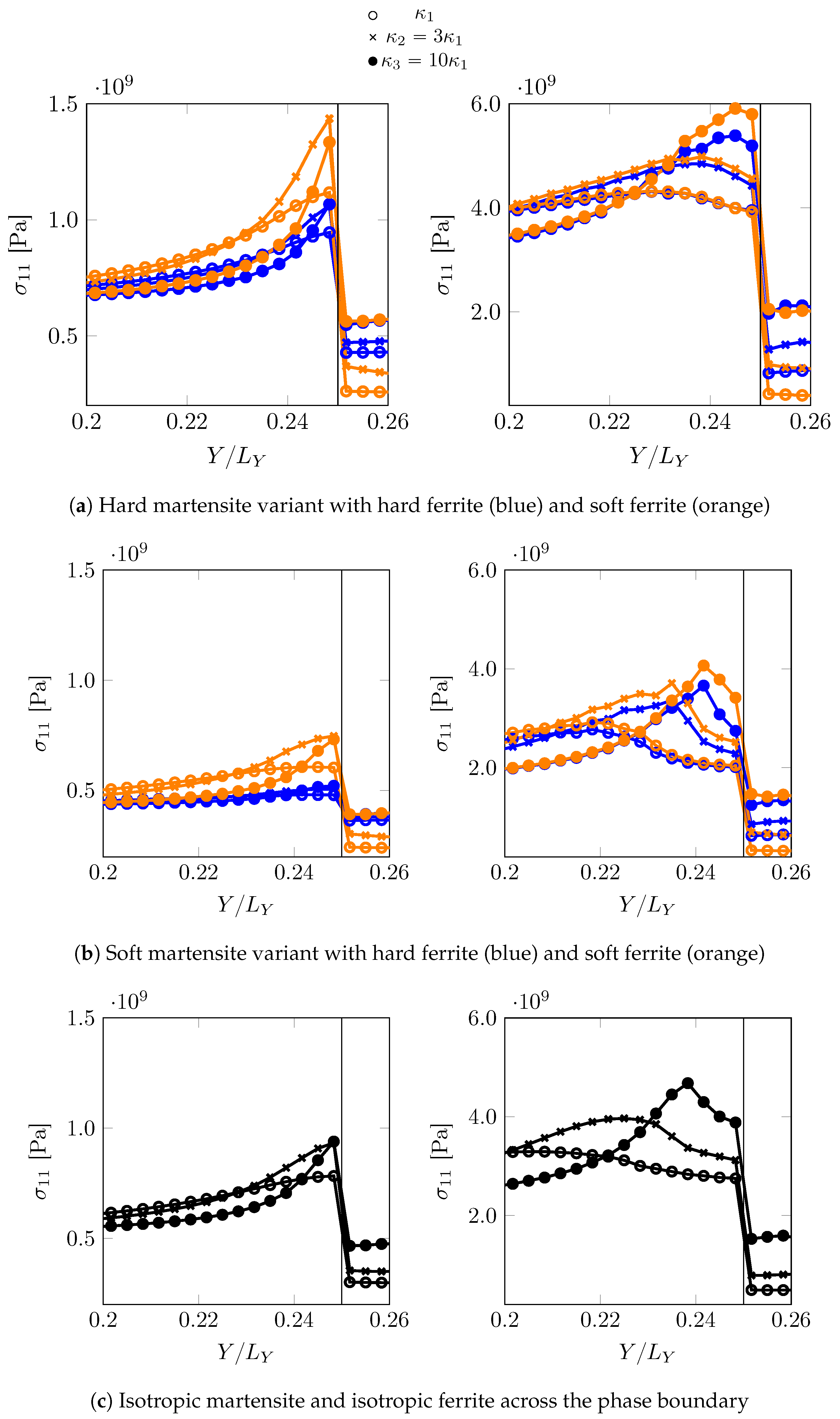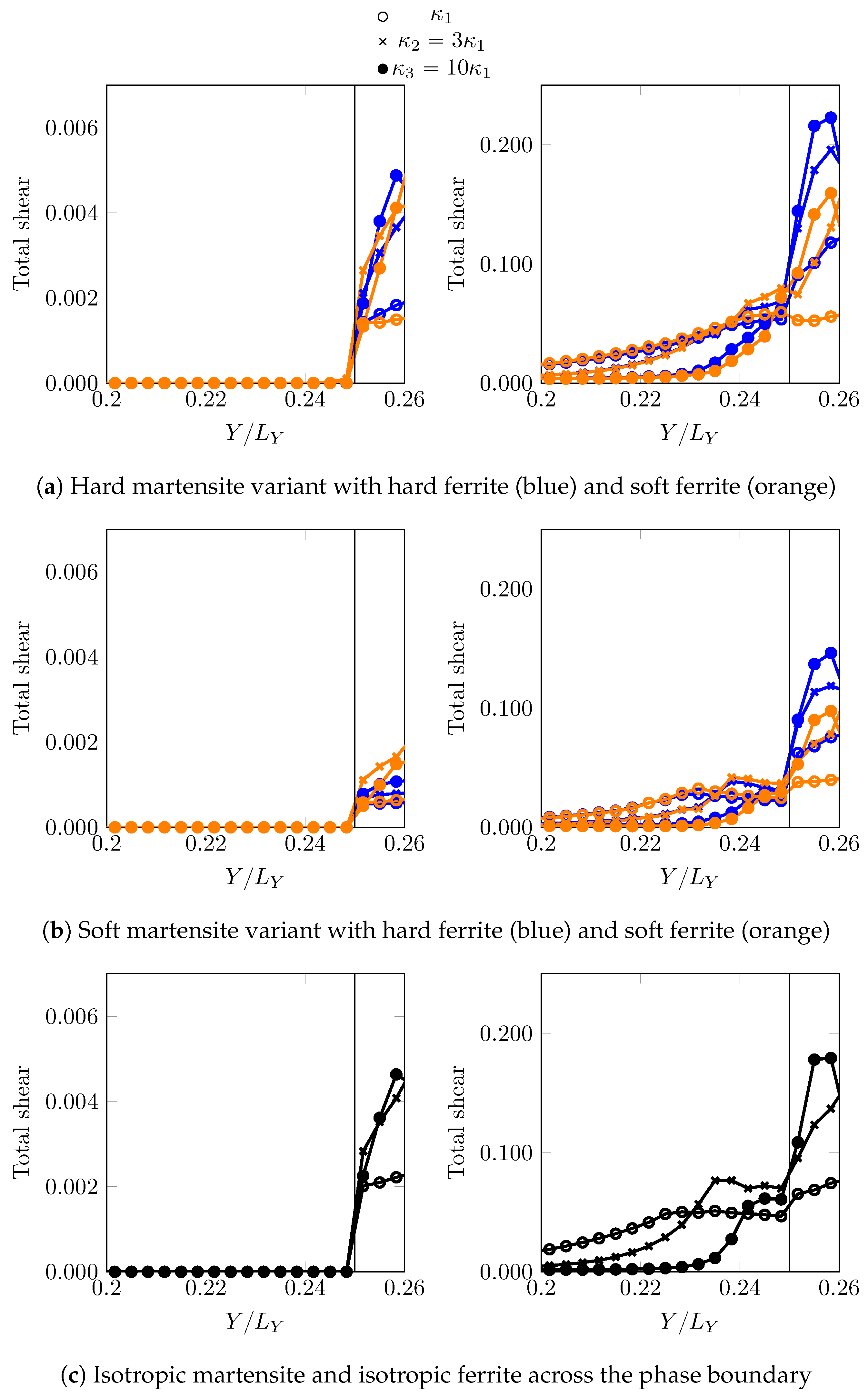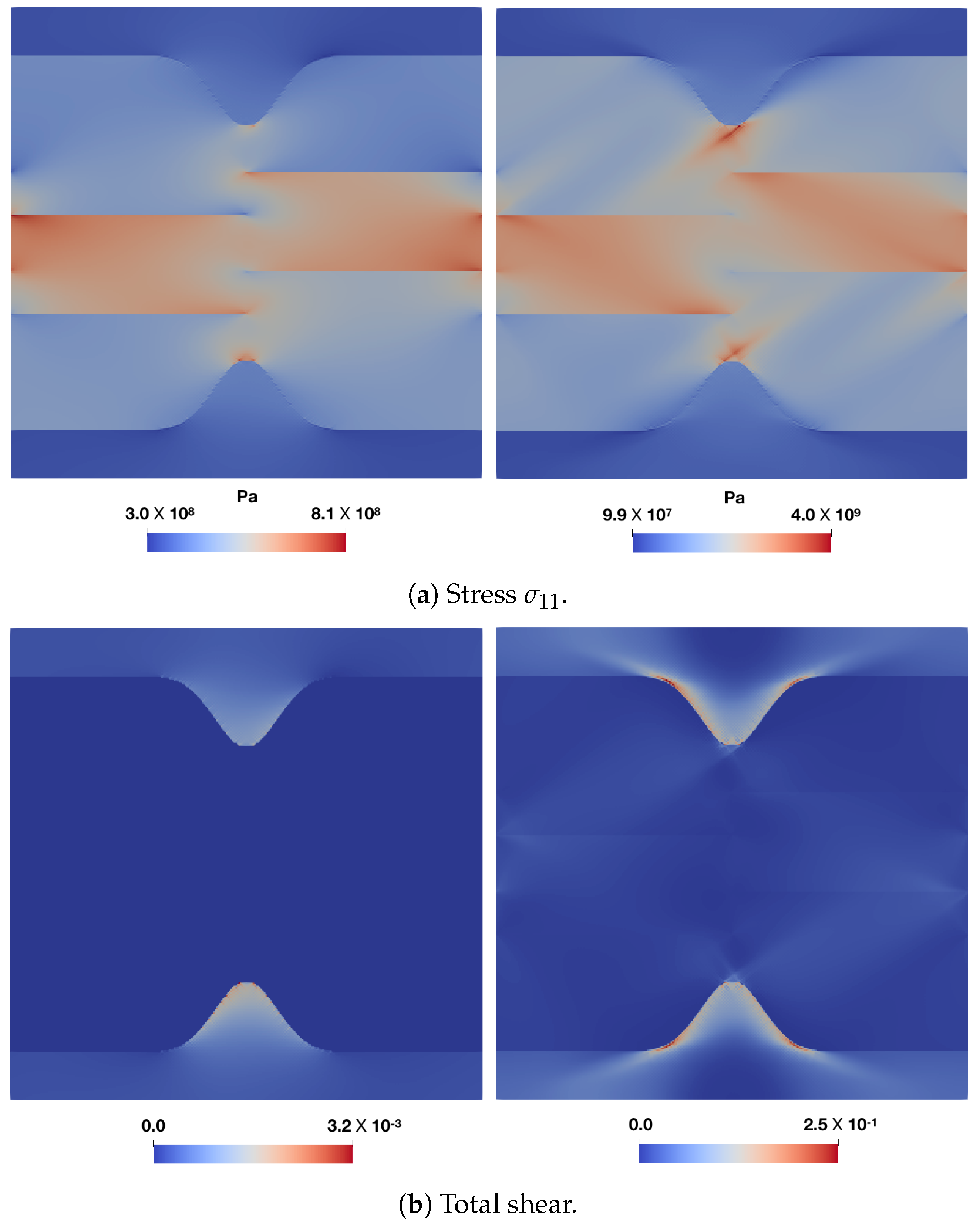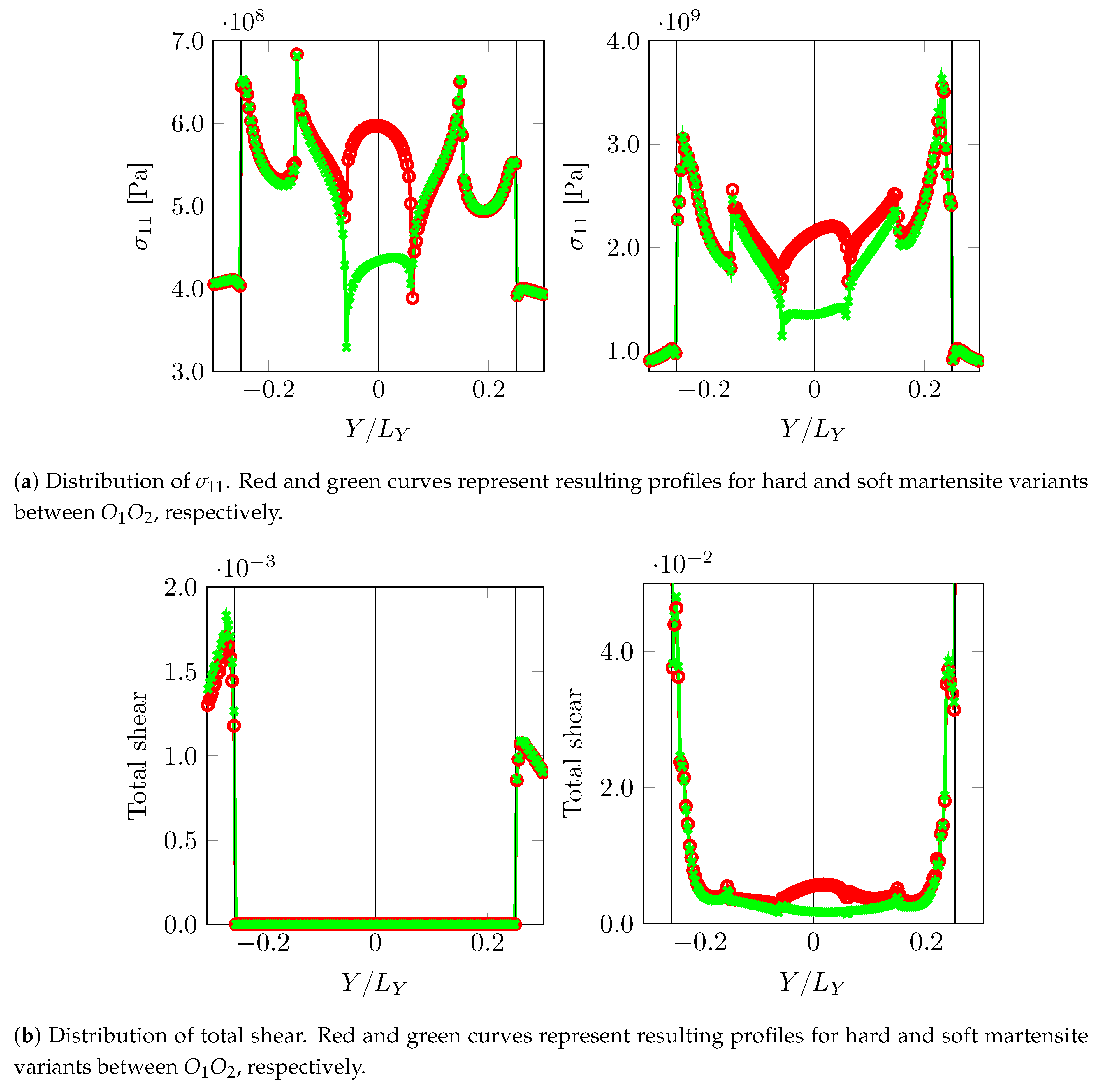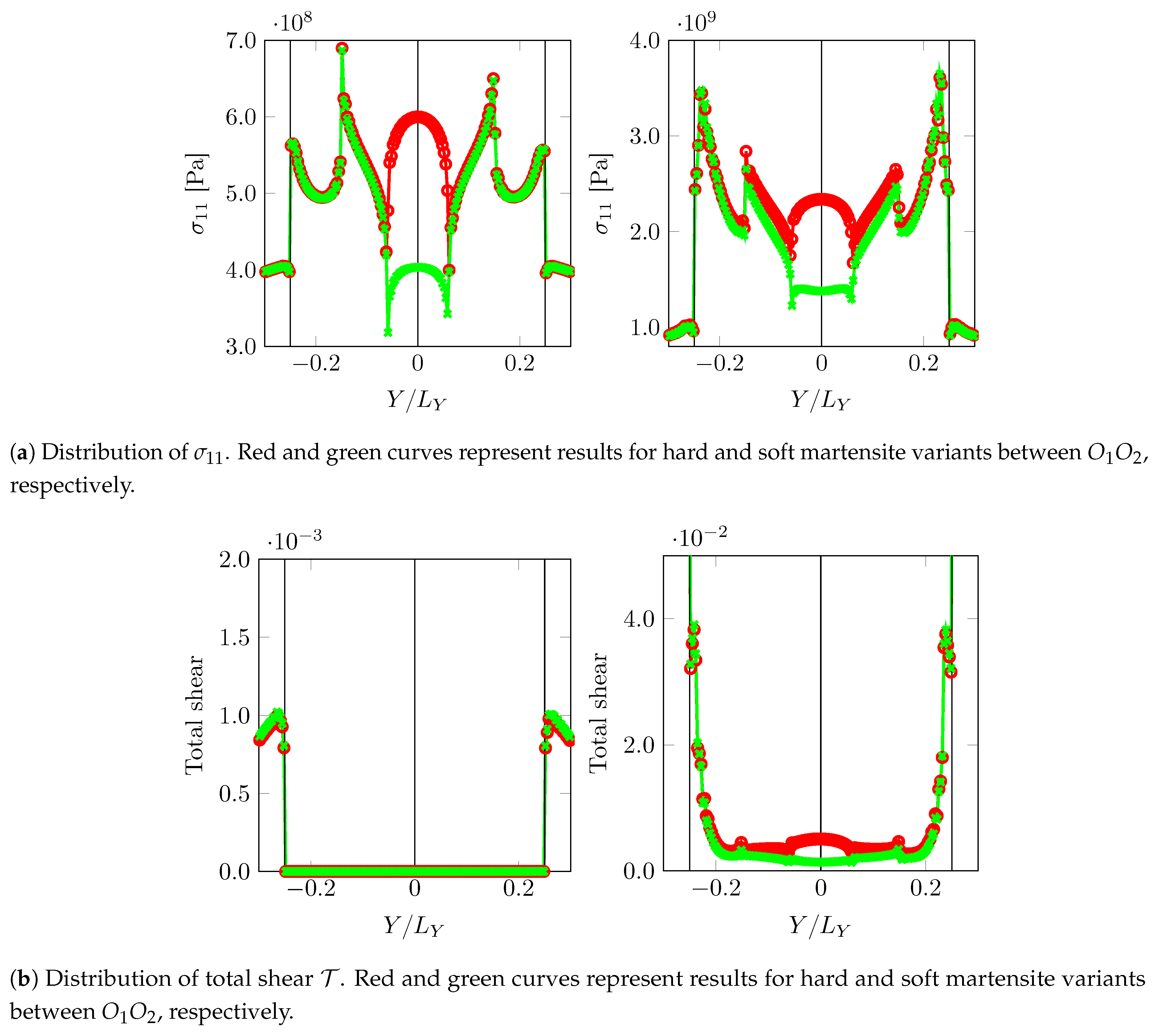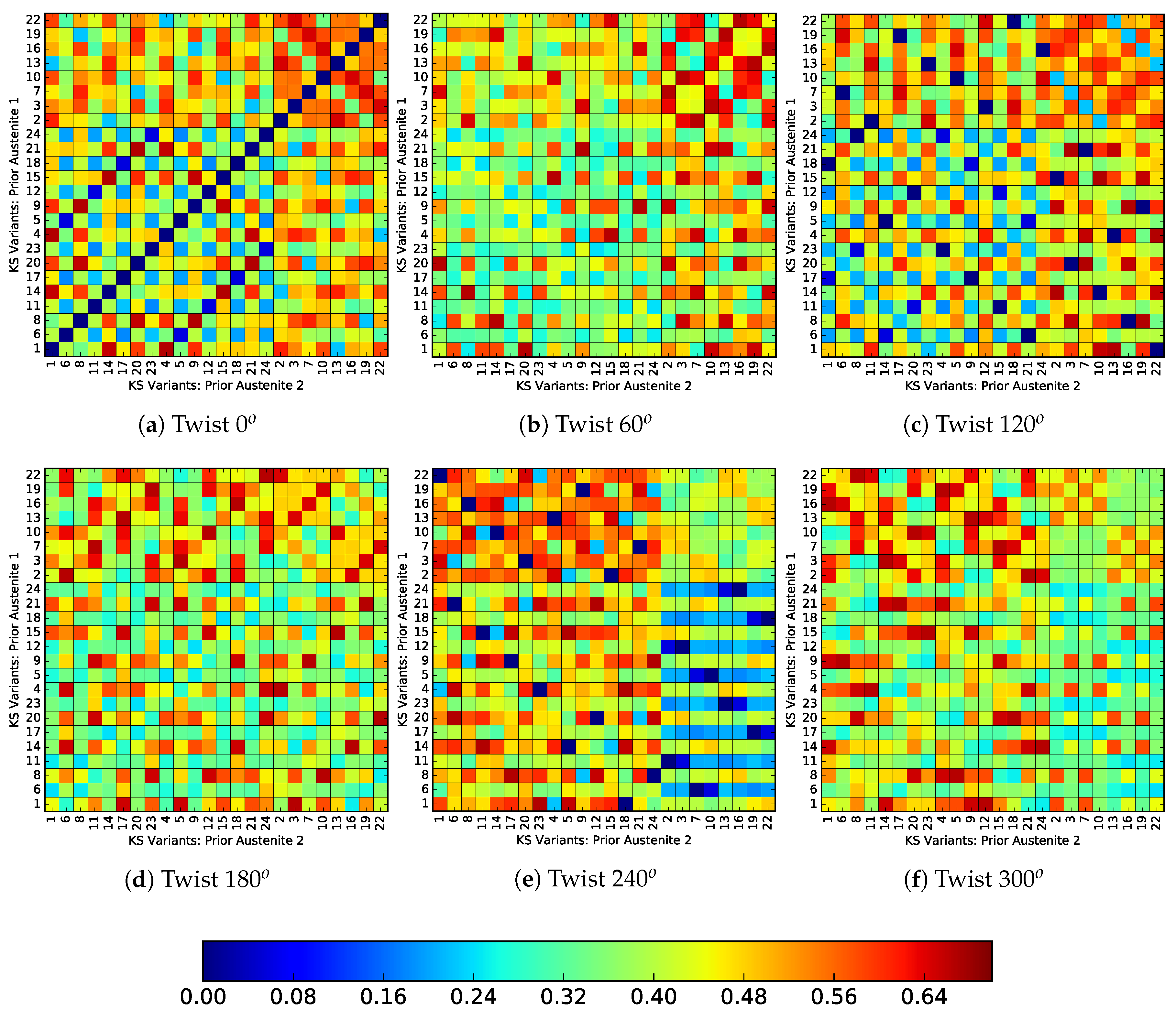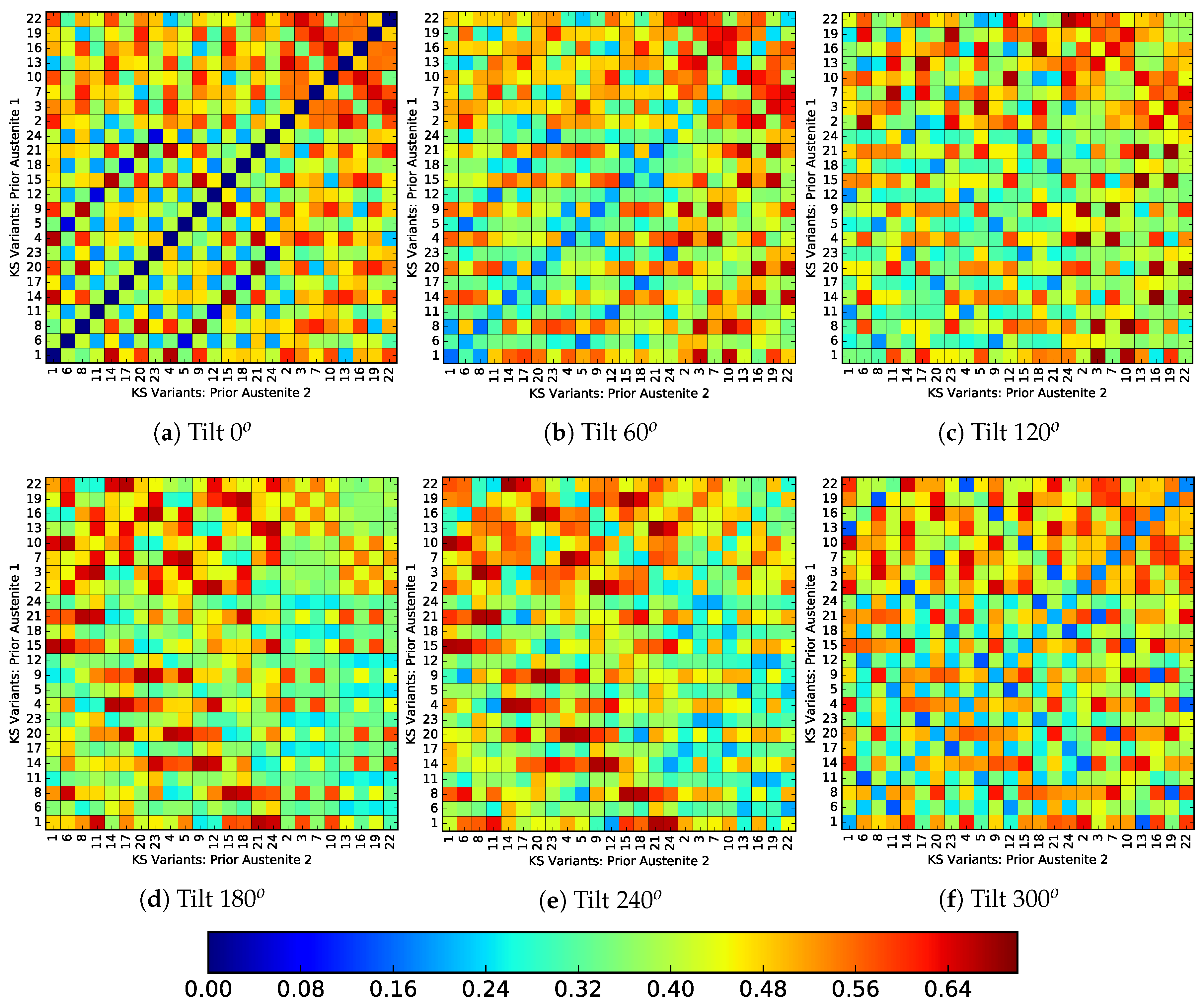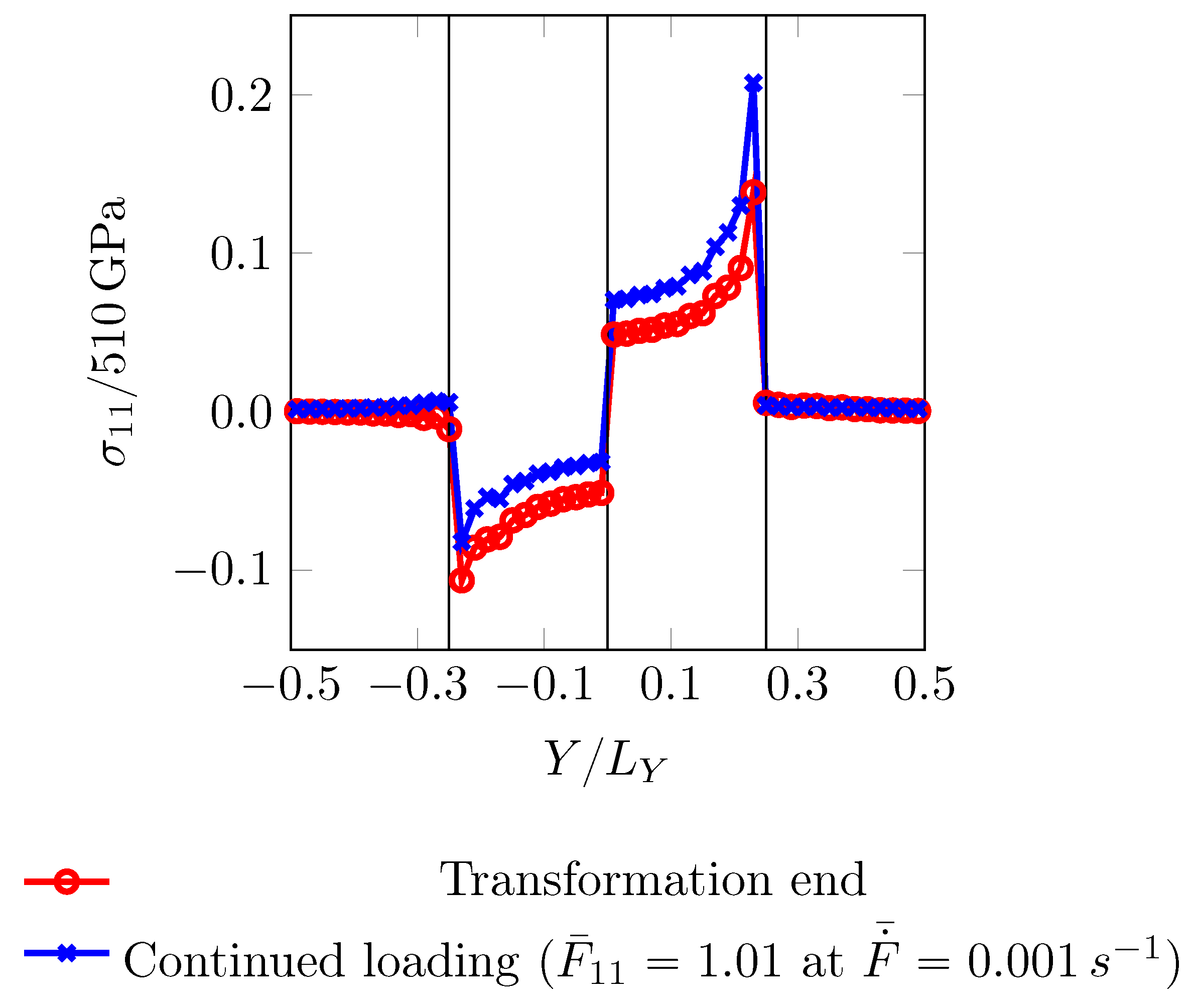3.1. Microstructural Volume Element and Loading Conditions
Computational tools that can simulate the mechanics of complex DP-steel microstructures exist, see for example open source code
DAMASK. In order to develop a clear understanding, in this contribution we restrict the study to a small region of interest as shown in
Figure 3. The ferrite–martensite phase boundary has a curvature
at the point of intersection with the PAGB. The size of the simulation geometry is denoted by
. A columnar grain assumption is made in the out-of-plane direction. It consists of a ferritic region and a martensitic band that emanates from two prior austenite grains separated by the PAGB
. The grains within martensite regions are assumed to have simplified rectilinear shape around the PAGB. The martensite grain orientations are related to the orientation of the prior austenite from which they emanate. Choosing these orientations in further analysis allows us to obtain a substructure with tunable complexity. Since martensite is the major focus of this study, no grain structure within ferrite is considered, i.e., the ferrite region has a single orientation.
The boundary value problem for the mechanical equilibrium of the volume element is solved using an FFT-based spectral solver, which entails periodic boundary condition on the solution field variables of the problem. The resolution of the Fourier grid used is
. The loading condition defined in terms of overall rate of deformation gradient
and the overall Piola–Kirchhoff stress
is
Equation (
10) implies an applied deformation in X-direction, free contraction in Y-direction and a plane strain assumption in out-of-plane direction. The * refers to an unconstrained deformation/unprescribed stress component.
Before analysing the micromechanical response of the volume element (
Figure 3), single-crystal responses and the effect of phase boundary curvature on individual martensite variants is investigated. These auxiliary studies can help in finding crystals which can be used to render the microstructure critical. The former helps in finding mechanically contrasting crystals which when placed nearby each other in
Figure 4, may lead to stress concentration upon loading. The latter helps in selecting crystals which when placed near the curved phase boundaries lead to comparatively low stresses.
3.2. Single Crystal Variant Responses to Identify Hard–Soft Variants
In order to consider only critical volume elements, the crystallographic orientations of martensite and ferrite that lead to such situation are needed. In order to achieve that, qualitative input on the hardening behavior of the martensite variants and ferrite crystals is required. Due to the special orientation relationship (
Section 2.2) between the martensite variants and the prior austenite grains, it is important to choose the orientation of the latter first. The orientation of the prior austenite grains adjacent to the PAGB may depend on the processing conditions. In order to keep the analysis generic two prior austenite orientations—referred to as
and
—are arbitrarily chosen and considered for further analysis. Both orientations align the FCC habit planes
with the prior austenite grain boundary, but they have a twist misorientation between them. The Euler orientation triplets corresponding to them are given in
Table 2.
Corresponding to each prior austenite orientation there are 24 KS-OR related martensite variant orientations, giving rise to numerous possible combinations that can be used to assign the grain orientations in the martensitic substructure. Identifying the martensite variants of each prior austenite as elastically and plastically hard or soft, in the primary loading direction, allows the ability to achieve a critical substructure without considering all mathematically possible combinations. Since anisotropic crystals are being dealt with, which have directional micromechanical response, stress–strain measures need to be defined, on the basis of which they can be rendered hard or soft. For the elastic regime, the slope of
as a function of
or the directional stiffness
is used. For analysis in the plastic regime, the assessment of hard/soft variants is even more difficult because of the large non-linearity triggered by different model parameters. The hardening parameters, the orientation of active slip systems and the mutual interaction complicate such an analysis. Such an identification may even be transient. Nevertheless, two flow stress values can be used to assess hardness; the von Mises measure of Cauchy stress at low plastic strain
and the same at a comparatively high plastic strain
. Simulations are performed on martensitic single crystals with the orientation of the variants related to the two different prior austenite grains. The loading condition, Equation (
10), used here is the same as the one that is intended for the simulation of the full volume element, shown in
Figure 3.
Figure 5 shows the directional stress–strain responses in the different regimes as discussed above. It is noted here that only the results of the first six variants, corresponding to the FCC habit planes
and
, are depicted. Due to symmetry, the directional response of the other 18 variants coincides with that of one of the first six variants, thus giving only six or less unique curves in terms of above mentioned stress–strain measures. For prior austenite
, the scatter between the directional micromechanical responses of the variants is a little higher than for
. The variants of both prior austenites show a significant scatter. Thus choosing hard–soft variants from them may provide significant micromechanical contrast in the sub-structural response.
Figure 5a shows that the scatter in the directional elastic response of the variants from different prior austenite is different.
Figure 5b shows the yield response of different variants. It correlates well with the elastic behavior shown in
Figure 5a. At significantly higher plastic strain,
Figure 5c, deviations in the trend arise due to differences in hardening behavior.
The result of this analysis is given in
Table 3, where the hard and the soft variants, for different strain regimes are listed.
Similarly, a ferrite single crystal
with orientation given by the Euler triplet set
is identified as directionally hard whereas
is identified as soft. Their elasto-plastic responses are shown in
Figure 6.
The response of these variants in actual microstructural calculations may significantly change due to microstructural features—phase boundary curvature and martensite substructure near the PAGB (triple junction, distance between triple junctions, active slip-systems, etc.). Note that these single crystal responses only give a qualitative impression of the hardness.
3.3. Influence of Phase Boundary Curvature
The curved phase boundaries, although they are not a “notch”, but due to geometry and mechanically contrasting phases may still cause stress concentrations. At the intersection of the curved phase boundaries with the PAGB, the major factors affecting the stress–strain behavior are the curvature
, the martensite variants adjacent to the tip and the surrounding ferrite. In this section, the analysis is restricted to the earlier identified hard and soft variants resulting from prior austenite
, see
Table 3. The effect of phase boundary curvature is analysed using the volume element shown in
Figure 3 with different phase boundary curvatures:
,
and
, where
is given in
m. The zoomed-in section of these volume elements is depicted in
Figure 7. The substructure is not populated yet, rather one single orientation (hard or soft) for both the ferrite and martensite region is used. This also implies there is no PAGB or can be considered “pseudo” PAGB with zero misorientation.
In total four combinations are investigated: hard martensite–soft ferrite, hard martensite–hard ferrite, soft martensite–soft ferrite and soft martensite–hard ferrite. Stress and strains ahead of the phase boundary along the path (closest resolved grid points parallel to “pseudo” PAGB at ) are analysed at two different instants: when the martensite is in the elastic regime () and when the martensite has yielded ().
The stress
and total shear
distribution profiles for all these cases are shown in
Figure 8 and
Figure 9. For the low overall deformation,
, when martensite responds elastically, the peak stress, which is higher for the harder martensite variant, is close to the tip. Having a softer ferrite near the phase boundary, amplifies the peak stresses significantly. Once the region ahead of the curved phase boundary yields (
Figure 9), for example at an overall deformation of
, the stress maximum shifts further away. The decay of stress seems characteristic of the phase boundary curvature, implying a sharp drop for sharp curvatures. At low overall deformation, i.e.,
, the maximum stress in the martensite ahead of the curvature does not relate linearly with the curvature of the phase boundary. It is comparable for
and
in case of
, and almost coincides when the adjacent ferrite is
. In fact,
overcomes
(with sharper curvature) in maximum stress when surrounded by soft ferrite
in
Figure 8a. In order to verify whether this is related to the local crystallography or crystallographic differences, a comparison (
Figure 8c and
Figure 9c) is made with a reference simulation using an isotropic plasticity model parameter (
Table 4), which shows a similar trend at
, where the profiles for
and
almost coincide. For deformation in the plastic regime of martensite at
, the ambiguity of the relation with the phase boundary curvature vanishes and a systematic trend of higher stress for sharper curvature is observed, which may be related to the size of the yield zone ahead of the curved tip.
In all the cases, the ferrite deforms significantly more than martensite. This is particularly the case when it is more confined, i.e., for higher curvatures . This simple comparison highlights the importance of local crystallinity near the curved phase boundary and its possible interplay with the phase boundary morphology (curvature).
3.4. Influence of Martensite Substructure
After gaining some clarity on the response of individual crystals (martensite variants and ferrite) and around curved phase boundaries, focus is next put on the other microstructural characteristics. The knowledge of the micromechanical response of the hard–soft martensite variants allows to assign variant orientations to the grains in
Figure 4 such that a critical configuration is obtained. The substructure typically consists of triple and even higher order junctions. Triple junctions with surrounding grains of high incompatibility—caused by high micromechanical contrast or mismatch in active slip planes/directions—are preferred regions for stress concentrations. At triple junctions, the orientation of the intersecting interfaces and the hardness of the surrounding variants can be important factors governing stress concentrations. The distance between triple junctions can also influence the stress field in between them.
The knowledge of hard–soft martensite variants,
Table 3, can now be used to create junctions that have high mechanical contrast. The curvature of the phase boundary used is
. Since a critical configuration requires to avoid high stresses at the phase boundary, the grains (1, 4, 5 and 8) near them should be assigned the orientations of the softer variants corresponding to the respective prior austenite grain. Grains 3 and 6 are assigned a hard variant, while grains 2 and 7 are assigned the soft variant of the corresponding prior austenite based on
Table 3, providing four contrasting triple junctions along the PAGB. The ferrite orientation
is considered, as it was found to reduce stress concentrations at the curved phase boundaries in
Section 3.3. Two different realizations of the martensite band
Figure 4 are considered:
(hard bridging martensites across
) and
(soft bridging martensites across
). Positive and negative values for
refer to situations when the bridging martensite variants are both hard and both soft, respectively.
In the first set of substructure simulations, the prior austenite orientations
and
are considered for the two grains.
Figure 10 shows the distribution of the
component of Cauchy stress and total accumulated shear (
) in the volume element.
The curved phase boundaries and the triple junctions are clearly the regions of intensive stress or strain activity. The amount of plastic activity in ferrite is expectedly larger than in martensite. Since the region near the PAGB is in the focus of this work, stress
and strain (total shear
) profiles along a parallel line close to it (
) are plotted in
Figure 11 at two different deformation levels
(left column) and
(right column).
The decay of stress from the phase boundary curvature tip is similar for all the cases. The stress levels fluctuate significantly at the junctions. In the regime of martensite responding elastically, i.e., at , the stress around the triple junction () is almost as high or higher than at the curved phase boundaries. This is the situation that can lead to stress concentration away from the phase boundaries if the critical stress for damage initiation is at a similar level. The regions around the triple junctions () show a sharp dip in the stresses. This is attributed to the anisotropy of the surrounding crystals deforming to accommodate the incompatibility at these triple junctions. The level of stress between seems to be governed by the directional hardness of the bridging martensite crystals. Once the plasticity in martensite initiates, stresses at the phase boundary become higher. This is attributed to the modest amount of hardening at the triple junctions along the PAGB. Even at a low plastic strain of ∼0.006 along the PAGB, the transition of higher stress to the curved phase boundary occurs. This transition stage is highly dependent on the local crystallography (misalignment of the active slip systems, etc.).
One can conclude that “critical” martensitic substructures can be obtained given a combination of variants providing the required mechanical contrast and crystallography are present in the neighborhood. This situation can also be achieved even when the misorientation of the prior austenite grains is low or even zero as shown in
Figure 12. Whether such substructures are plausible as a product of transformation processes is difficult to answer and is the subject of transformation modeling. Knowledge of transformation strains, Equation (
9), can still be used to get some insights on their inter-compatibility and is discussed next.
3.5. Transformation Strains and Residual Stresses
The previous section assessed the risk for PAGB damage based on the micromechanical response only, given a crystallographic arrangement of martensite variants in a simplified volume element,
Figure 3. A crystallography based explanation for experimentally observed stress driven decohesion at different locations along a PAGB was supported. Variant arrangements resulting in less frequently observed decohesion locations, i.e., away from the curved phase boundaries (bounded by martensite phase only), could easily be created. Existence of such substructures in real microstructures is subject to the transformation process (nucleation location, kinetics, transformation-sequencing, etc.).
Transformation modeling can take these aspects into account. For example, phase field based modeling of such transformation processes, refs. [
20,
21] is inherently capable of capturing the energetic principle based nucleation and growth of martensite variants. The competing kinetics can also be captured using gradient flow models of the Ginzburg–Landau type. Most of the modeling tools are, however, not fully developed for the problem at hand and do not account for all possible nucleating variants corresponding to an orientation relation scheme, with the exception of [
22]. Within this restriction, the knowledge of transformation strains associated with individual variants can still be used to extend the understanding gained in the previous section. We propose two further conditions which may support cracking along the PAGB, away from notch like stress concentrators at its intersection with phase boundaries. Both situations relate to the accommodation of transformation strains in the surrounding material.
3.5.1. Strain Incompatibility
The transformation (lattice) strains corresponding to different martensite variants can be strongly anisotropic, see Equation (6). The Bain strain
, Bain strain-related rotation
, austenite orientation
and the symmetry group rotations
, all contribute to this anisotropy. The transformation strains of variants around the PAGB and their mismatch will have to be accommodated by the surrounding material. Nucleating variants tend to minimize this incompatibility, which is also supported by energy minimization principles. Due to the lack of an appropriate model of this type, a theoretical analysis on compatibility of the transformation strains, that relies on the definition of an incompatibility measure for PAGB transformation strains, is presented. Considering a PAGB segment with an interface normal
, composed of two abutting variants and given the jump in their transformation strain,
, across the interface, the incompatibility can be quantified using Equation (
11).
The transformation of martensite can initiate either from the interfaces or from inclusions (particles in the bulk of the austenite). In the inclusion case, the presence of a variant at the PAGB is a consequence of the nucleation sequence away from the concerned PAGB. This does not necessarily allow the PAGB segments to be compatible by variant selection as they may have nucleated at other locations of compatibility and grown towards the PAGB considered. Based on earlier work [
12], where the habit planes aligned with the PAGB, normal were suggested to be favorable, the investigation is narrowed by only considering transformation of such prior austenite grains. A relationship between the prior austenite grain boundary character and the transformation strain compatibility across
is sought. Departing from prior austenite orientations that align a habit plane
with the PAGB, various other orientations can be obtained by rotating the crystal about the
X axis, giving twist misorientation, or about
Z (where
Z is out of the plane direction), giving tilt misorientation.
Figure 13 and
Figure 14 show the incompatibility between variants originating from different prior austenite orientations, for a twist misoriented and tilt misoriented PAGB respectively. The horizontal and vertical axes showing the variant numbers of prior austenite 1 and prior austenite 2, respectively. The variant numbers are ordered according to the Bain group, i.e., the eight variants each of group C first, followed by group B and then group A. The color of each voxel represents the incompatibility between the respective variants according to Equation (
11). The set of lattice parameters of pure iron (
) based on [
2] are used. For a PAGB with zero misorientation,
Figure 13a and
Figure 14a, show that a fully compatible interface is only obtained for identical variants on either side. Combinations resulting in minimum incompatibility
are obtained after each
twist,
Figure 13c,e, which is related to the in-plane direction symmetry. In
Figure 13c,e it can be seen that the compatible variants do not necessarily lie within the same Bain group.
It is important to note here that the cleavage planes from the same group have low misorientation [
14]. So, if the PAGB were to become weaker on account of cleavage planes aligning with the PAGB, the selection of variants from different groups can enhance the strength. Or, at least render it stronger than when both variants were from the same group, with their low misoriented cleavage planes aligned with the PAGB. On the other hand, the tilt misoriented PAGBs do not show as good compatibility as compared to the twist misoriented ones. In fact no combination of
is observed.
The situation may be even more complex at the triple junctions along the PAGB. The incompatibilities may or may not be accommodated at the PAGBs. Typically, the incompatibilities can be accommodated by plastic straining of the parent austenite grain. This may leave significant amounts of dislocations at the boundaries which may affect their local hardening behavior. The residual stresses thus left may remain in the material after processing, which can be detrimental to the strength of the PAGB. If not accommodated, they may even leave regions of retained FCC phase which may increase the toughness of the PAGB by further transformation upon.
3.5.2. Tension–Compression Residual Stresses
Another interesting aspect of the transformation strain is the tension and compression along different axes. Such transformation strains can leave residual stresses of tensile or compressive nature depending on the orientation of the Bain axis and the constraints induced from the surroundings. It is well possible that compressive stresses near the phase boundaries suppress the damage initiation.
In order to demonstrate this phenomenon, a simulation on a volume element as depicted in
Figure 15 is performed.
Figure 15 has same overall dimensions as
Figure 3. In a first step, transformation strains as given in
Table 5 are assigned to different regions.
The transformation is assumed to take place in a fully martensitic elastic media. During this transformation a boundary constraint as given by
is enforced. The martensite accommodating the transformation strains is also constrained by the surrounding ferrite. This process gives rise to residual stresses. Stress component
along
is plotted in
Figure 16. From this state, a loading is applied to achieve the final overall deformation state defined by
within 10 s.
at the end of this continued loading is also plotted in
Figure 16. It can be seen that the initially compressed region loads up slower as compared to the rest and may achieve a critical stress only at higher overall strain level.
